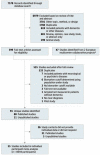Prevalence of cerebral amyloid pathology in persons without dementia: a meta-analysis
- PMID: 25988462
- PMCID: PMC4486209
- DOI: 10.1001/jama.2015.4668
Prevalence of cerebral amyloid pathology in persons without dementia: a meta-analysis
Abstract
Importance: Cerebral amyloid-β aggregation is an early pathological event in Alzheimer disease (AD), starting decades before dementia onset. Estimates of the prevalence of amyloid pathology in persons without dementia are needed to understand the development of AD and to design prevention studies.
Objective: To use individual participant data meta-analysis to estimate the prevalence of amyloid pathology as measured with biomarkers in participants with normal cognition, subjective cognitive impairment (SCI), or mild cognitive impairment (MCI).
Data sources: Relevant biomarker studies identified by searching studies published before April 2015 using the MEDLINE and Web of Science databases and through personal communication with investigators.
Study selection: Studies were included if they provided individual participant data for participants without dementia and used an a priori defined cutoff for amyloid positivity.
Data extraction and synthesis: Individual records were provided for 2914 participants with normal cognition, 697 with SCI, and 3972 with MCI aged 18 to 100 years from 55 studies.
Main outcomes and measures: Prevalence of amyloid pathology on positron emission tomography or in cerebrospinal fluid according to AD risk factors (age, apolipoprotein E [APOE] genotype, sex, and education) estimated by generalized estimating equations.
Results: The prevalence of amyloid pathology increased from age 50 to 90 years from 10% (95% CI, 8%-13%) to 44% (95% CI, 37%-51%) among participants with normal cognition; from 12% (95% CI, 8%-18%) to 43% (95% CI, 32%-55%) among patients with SCI; and from 27% (95% CI, 23%-32%) to 71% (95% CI, 66%-76%) among patients with MCI. APOE-ε4 carriers had 2 to 3 times higher prevalence estimates than noncarriers. The age at which 15% of the participants with normal cognition were amyloid positive was approximately 40 years for APOE ε4ε4 carriers, 50 years for ε2ε4 carriers, 55 years for ε3ε4 carriers, 65 years for ε3ε3 carriers, and 95 years for ε2ε3 carriers. Amyloid positivity was more common in highly educated participants but not associated with sex or biomarker modality.
Conclusions and relevance: Among persons without dementia, the prevalence of cerebral amyloid pathology as determined by positron emission tomography or cerebrospinal fluid findings was associated with age, APOE genotype, and presence of cognitive impairment. These findings suggest a 20- to 30-year interval between first development of amyloid positivity and onset of dementia.
Figures




Comment in
-
Defining amyloid pathology in persons with and without dementia syndromes: making the right diagnosis.JAMA. 2015 May 19;313(19):1913-4. doi: 10.1001/jama.2015.5361. JAMA. 2015. PMID: 25988459 No abstract available.
-
Amyloid Pathology, Cognitive Impairment, and Alzheimer Disease Risk.JAMA. 2015 Sep 15;314(11):1177. doi: 10.1001/jama.2015.9716. JAMA. 2015. PMID: 26372590 No abstract available.
-
Amyloid Pathology, Cognitive Impairment, and Alzheimer Disease Risk--Reply.JAMA. 2015 Sep 15;314(11):1177-8. doi: 10.1001/jama.2015.9719. JAMA. 2015. PMID: 26372591 No abstract available.
References
-
- World Health Organization Dementia: a public health priority. Apr 27, 2015. http://www.who.int/mental_health/publications/dementia_report_2012/en/
Publication types
MeSH terms
Substances
Grants and funding
- R01 AG13616/AG/NIA NIH HHS/United States
- P01 AG026276/AG/NIA NIH HHS/United States
- CAPMC/ CIHR/Canada
- P50 AG005133/AG/NIA NIH HHS/United States
- RF1 AG025516/AG/NIA NIH HHS/United States
- R01 AG12101/AG/NIA NIH HHS/United States
- P01 AG025204/AG/NIA NIH HHS/United States
- R01 AG025516/AG/NIA NIH HHS/United States
- U19 AG032438/AG/NIA NIH HHS/United States
- R01 AG022374/AG/NIA NIH HHS/United States
- P30 AG010124/AG/NIA NIH HHS/United States
- R01 AG013616/AG/NIA NIH HHS/United States
- U01 AG024904/AG/NIA NIH HHS/United States
- U19 AG010483/AG/NIA NIH HHS/United States
- P01 AG003991/AG/NIA NIH HHS/United States
- P30 AG008051/AG/NIA NIH HHS/United States
- P50 AG005681/AG/NIA NIH HHS/United States
- R37 AG025516/AG/NIA NIH HHS/United States
- R01 AG012101/AG/NIA NIH HHS/United States
LinkOut - more resources
Full Text Sources
Other Literature Sources
Medical
Miscellaneous

